Transform your backyard into a lush, green haven with these expert gardening tips and ideas. Whether you have a spacious outdoor garden or a small indoor space, these tips will help you create a beautiful and thriving green paradise.
Key Takeaways:
- Plan your garden carefully and consider the design, maintenance, and tools needed.
- Choose the right plants for your garden, considering factors like climate, sunlight, and soil conditions.
- Utilize vertical elements, such as walls and trellises, to maximize your garden space.
- Create functional zones in your garden, dividing the area into lounging, dining, and gardening spaces.
- Embrace pruning, composting, and natural pest control methods to maintain a healthy garden.
When it comes to gardening, planning is essential. Start by assessing your garden space and considering your goals and preferences. Think about the design, maintenance, and tools you will need to create your green paradise.
Choosing the right plants is key to a successful garden. Consider the climate, sunlight, and soil conditions in your area, and select plants that are well-suited for your garden. Whether you prefer outdoor gardening or indoor gardening, there are plenty of options to choose from.
Don’t forget to utilize vertical elements in your garden. Walls, fences, and trellises can be used to grow climbing plants, adding visual interest and maximizing your garden space. These vertical elements can create a visually stunning green space, even in small areas.
Creating functional zones in your garden can help make the most of your space. Divide your garden into distinct areas for lounging, outdoor eating, and gardening activities. This will provide a sense of organization and make your garden more enjoyable.
Maintaining a healthy garden requires regular pruning, composting, and natural pest control methods. Pruning helps promote healthy growth and enhances the overall appearance of your garden. Composting provides essential nutrients for your plants and reduces waste. Natural pest control methods, such as introducing beneficial insects and companion planting, create a balanced ecosystem in your garden.
By following these top tips, you can transform your garden into a green paradise. Whether you enjoy outdoor gardening or indoor gardening, organic gardening or vegetable gardening, these tips will help you create a beautiful and thriving space to enjoy.
Designing a Small Garden
Even a small garden can be transformed into a beautiful oasis with the right design and plant choices. Whether you have a small garden space, a patio, or a courtyard in the city, there are plenty of gardening tips that can help you create a stunning outdoor retreat. Here are some ideas to consider when designing a small garden:
- Utilize Garden Space: When you have limited space, it’s important to make the most of every inch. Consider vertical gardening techniques like using trellises or hanging pots to maximize the use of your garden walls. Patio pots and containers can also be a great option for small gardens.
- Create Functional Zones: Divide your small garden into different areas based on their purpose. Designate an area for lounging, outdoor dining, and even a workstation if you enjoy gardening activities. This will help create distinct spaces within your garden and make it more functional.
- Consider Courtyards and City Backyards: If you have a small courtyard or a city backyard, think about how you can transform the space into a cozy outdoor retreat. Use furniture, lighting, and plants to create a welcoming atmosphere and make the most of your limited space.
By implementing these design ideas and considering the specific needs of your small garden, you can create a beautiful and functional outdoor space that brings joy and tranquility to your everyday life.
Even a small garden can be transformed into a beautiful oasis with the right design and plant choices.
Gardening in a Small Area
When gardening in a small area, it’s important to consider your goals and make the most of every surface to create a vibrant and visually appealing garden. Whether you have a tiny patio, a courtyard, or a compact backyard, there are several factors to keep in mind for successful gardening in compact areas.
First and foremost, establish your goals for the space. What do you hope to achieve with your garden? Do you want a relaxing oasis, a colorful flower garden, or a productive vegetable patch? By determining your garden goals, you can plan and arrange the space accordingly.
Next, think beyond the horizontal plane and consider utilizing vertical space. Walls, fences, and even windows can be transformed into lush green areas by planting vines or hanging window boxes. Vertical gardening not only maximizes space but also adds visual interest to your small garden.
When selecting plants for your compact garden, focus on those that add color and texture. Choose plants that have a variety of leaf shapes, sizes, and colors to create visual depth. Consider using cool hues like green, blue, and purple towards the back of your garden to create the illusion of distance, while warm hues like red, orange, and yellow can be placed in the center and front to make the space feel more intimate.
There are many small-space gardening ideas you can incorporate into your garden to make the most of the available space. One idea is to focus on foliage rather than flowers. By selecting plants with beautiful leaves, you can enjoy color and texture throughout the year, even when flowers are not in bloom.
Creating rich layers is another effective technique for small-space gardening. Just like in a forest, you can have a ground plane, a layer of shrubs, and a canopy of trees in your tiny garden. Plant perennials and compact varieties of shrubs beneath taller plants to add depth and interest to your garden.
Pruning can also help create more space and add structure to your small garden. By removing bottom limbs of larger shrubs, you can make room for underplantings of lush foliage or colorful blooms. Additionally, training fruiting or decorative trees as an espalier against a wall or fence can provide a distinctive focal point while maximizing space.
Don’t forget to incorporate edible plants into your small garden. Herbs like thyme and oregano make excellent groundcovers, while compact fruit trees like columnar apples and dwarf figs can be used as decorative elements. This way, you can have both beauty and functionality in your small garden.
For added visual appeal, consider using hardscape accents such as containers. Vibrant containers can add interest and color to your garden, especially in dining areas. Use the same plants or color schemes from the planting beds in your container plantings to create a cohesive look.
Another way to maximize space in a small garden is to utilize vertical elements like trellises, fences, and walls. By growing climbing plants on these structures, you can create a visually stunning green space that takes advantage of both the horizontal and vertical dimensions of your garden.
If you want to divide your small garden into functional zones, consider using thin, upright plant materials as barriers between different areas. This can help create a sense of organization and provide distinct spaces for lounging, outdoor eating, and gardening activities.
Lastly, don’t forget to use walls and fences as support for climbing plants. By providing shade and enclosure, vertical elements can add a delightful sense of depth and privacy to your small garden. Climbing plants also help absorb noise and pollutants, creating a healthier and more peaceful environment.
Overall, gardening in a small area requires careful planning and creativity. By considering your goals, using vertical space, selecting the right plants, and incorporating small-space gardening ideas, you can transform even the tiniest garden into a green paradise.
Take Away:
- Establish your gardening goals
- Utilize vertical space
- Choose plants for color and texture
- Focus on foliage
- Create rich layers
- Utilize pruning techniques
- Incorporate edible plants
- Use hardscape accents
- Consider vertical elements
- Create functional zones
- Utilize walls and fences for climbing plants
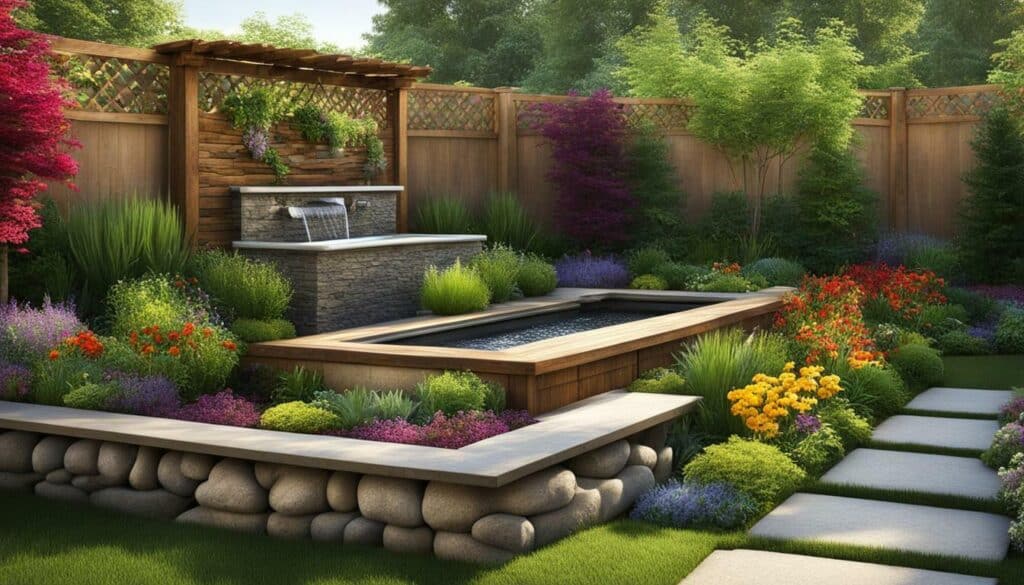
When gardening in a small area, it’s important to consider your goals and make the most of every surface to create a vibrant and visually appealing garden.
Choosing Plants for Small Gardens
Plant breeders have developed a wide range of compact plant materials specifically for small gardens, allowing you to create a stunning garden even in limited space. When it comes to choosing plants for your small garden, consider selecting varieties that are naturally compact or have a slow growth habit. These plants will not only fit well in small spaces but also require less maintenance in terms of pruning and trimming. Focal pieces, such as columnar trees and shrubs, can add vertical interest to your garden without taking up much horizontal space.
For example, consider incorporating the “Skyrocket” juniper (Juniperus scopulorum) into your small garden. Despite only spreading two to three feet wide, it adds evergreen color and creates a beautiful backdrop. Another option is the “Slender Silhouette” sweet gum (Liquidambar styraciflua), which features stunning fall leaves and has a narrow growth habit.
In addition to compact plants, think about the overall color scheme and visual impact of your garden. Choose plants that provide a beautiful backdrop for your garden, such as evergreen shrubs with interesting textures or colorful foliage. The right combination of plants can create a visually appealing and cohesive garden design.
Key Considerations for Plant Selection:
- Opt for compact plant varieties
- Choose focal pieces for vertical interest
- Select plants with evergreen color for year-round appeal
- Consider plants with beautiful foliage for added texture
- Create a cohesive color scheme
Remember to also take into account the specific growing conditions of your small garden, such as sunlight and soil type. Some plants may thrive in full sun, while others prefer shaded areas. Take the time to research and select plants that are well-suited to the microclimate of your garden.
By carefully choosing the right plants for your small garden, you can create a beautiful and thriving green space that serves as a focal point for your outdoor area. Whether you prefer a lush oasis or a minimalist design, there are plenty of options available that will allow you to make the most of your limited space.
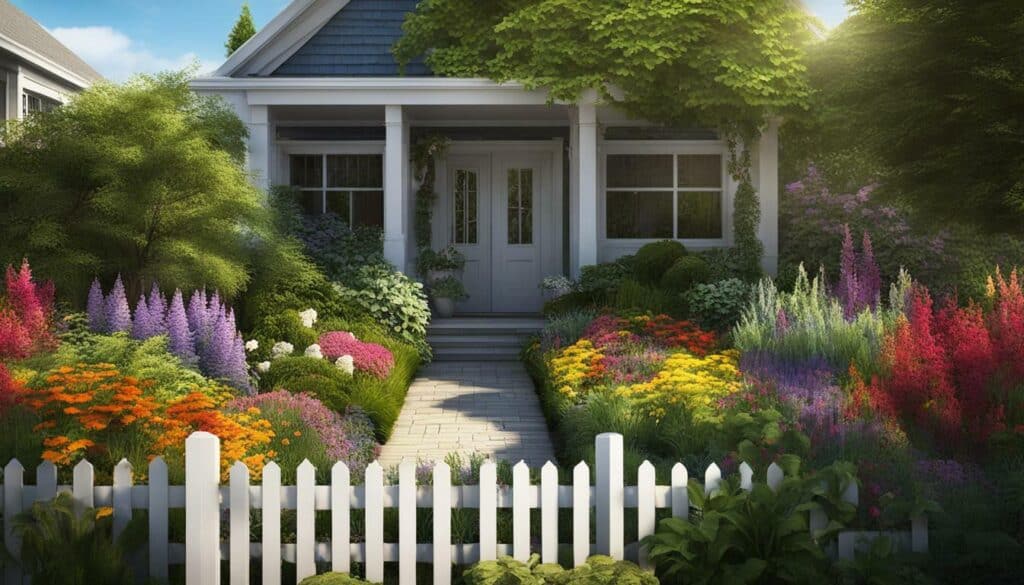
Source: seo-writing.ai
By strategically placing plants with cool and warm hues, you can create a garden that appears larger and more visually interesting. Cool hues like green, blue, and purple tend to recede from vision, making objects appear closer and smaller. On the other hand, warm hues like red, orange, and yellow accentuate an object’s size and proximity.
To provide visual depth in your garden, consider placing plants with cool colors toward the back of a planter or bed. This will create the illusion of distance, making the space appear larger. In contrast, plants with warm-hued leaves and blossoms can be placed in the center and front of the garden, drawing the observer’s eye and making the planting appear closer.
Proper plant selection is crucial for achieving the desired visual effect. Choose plants with different leaf colors and textures to add interest and depth to your garden. Mix foliage plants with flowers to create layers of color and texture. For example, combine plants with fine, feathery foliage with others that have bold, broad leaves. This contrast will create a dynamic visual display.
In addition to color and texture, consider the size and growth habit of the plants you choose. Opt for a mix of heights and shapes to create a sense of movement and variety in your garden. Tall, upright plants can provide a vertical element, while low-growing varieties can form a lush groundcover. Layering plants of different heights and forms will add depth and dimension to your garden design.
Remember to consider the specific needs of the plants you choose, such as sunlight requirements and soil conditions. Place sun-loving plants in areas that receive ample sunlight and shade-loving plants in areas with dappled or partial shade. Providing the right growing conditions for each plant will ensure their health and vitality, enhancing the overall visual appeal of your garden.
By incorporating cool and warm hues, layering plants, and selecting the right plant varieties for your garden, you can create a visually stunning and captivating outdoor space. Whether you have a small garden or a larger area to work with, these techniques will help you maximize the visual depth and beauty of your garden. So get out there, start planning, and let your green paradise thrive!
More Small-Space Gardening Ideas
Take your small-space gardening to the next level with these creative ideas, including focusing on foliage, creating layers, and incorporating edible plants.
Focus on the Foliage
One way to add color and texture to your small garden is by focusing on foliage. Instead of relying solely on flowers, consider incorporating plants with vibrant leaves. This can provide longer-lasting color and interest throughout the year. Choose plants with different leaf shapes, sizes, and colors to create visual variety.
Make Rich Layers
Creating layers in your small garden adds depth and visual interest. Start with taller plants at the back of your garden bed or container and gradually transition to shorter plants towards the front. Utilize perennials, grasses, and compact shrubs to fill in the middle layer. Finally, add ground covers or low-growing annuals as the front layer to create a lush and layered effect.
Pruning: How to Make the Most of It
Pruning is an essential technique for maintaining the size and shape of plants in a small garden. Regularly prune larger shrubs and trees to create space for underplanting with foliage or blooming plants. Additionally, consider training trees or shrubs as espaliers against walls or fences to maximize space and create a unique focal point.
Use Edible Plants as Ornaments
Don’t limit your small garden to purely ornamental plants. Incorporating edible plants not only adds beauty but also provides a source of fresh produce. Use herbs like thyme and oregano as ground covers, and grow vegetables like eggplants and peppers for their vibrant fruits. You can even incorporate dwarf fruit trees, like columnar apple or fig varieties, for a unique and productive garden.
Hardscape Accents with Containers
Make the most of your small garden by incorporating hardscape accents with containers. Use vibrant pots and planters to add visual appeal and create focal points. Choose containers that complement the overall design of your garden and consider incorporating similar plants or color schemes to tie everything together. Place containers strategically, such as alongside stairs or paved surfaces, to maximize space and create a cohesive look.
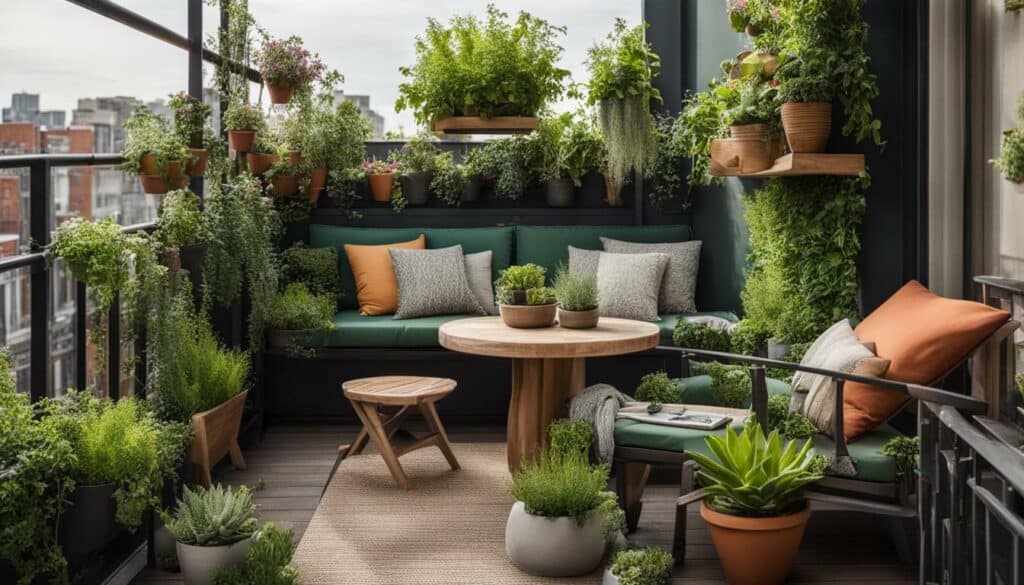
Consider Vertical Elements in the Garden
When space is limited, utilizing vertical elements can help you make the most of your small garden. Install trellises, fences, or walls to create vertical gardening opportunities. Plant climbing plants, such as Clematis or climbing roses, to add lush greenery and visual interest. You can also construct a small arbor to provide shade and create a charming focal point in your garden.
Distribute the Garden Area
Dividing your small garden into functional zones can create the illusion of more space and make it more efficient. Define lounging areas, outdoor eating areas, and workstations by using thin barriers made from plants or other materials. This not only adds structure and organization to your garden but also allows you to make the most of every square inch.
Provide Climbers with Walls and Fences
Don’t overlook the potential of walls and fences in a small garden. Utilize them as vertical space for growing climbing plants. Climbers not only add visual interest but also provide shade and a sense of enclosure. They can also help absorb noise and pollutants, creating a more peaceful and inviting garden environment.
Take Certain Indoor Elements Out
Extend your living space into your small garden by bringing indoor elements outdoors. Create cozy seating areas with outdoor furniture that complements your interior design. Add colorful outdoor lighting, such as fairy lights or lanterns, to create a warm and inviting ambiance. By blurring the boundaries between indoor and outdoor spaces, you can make your small garden feel like an extension of your home.
Establish a Small Herb Garden
Don’t overlook the potential of a small herb garden in your limited space. Repurpose a side table or coffee table to create a charming and handmade planting space for herbs. This allows you to have fresh herbs at your fingertips while adding a touch of greenery to your small garden.
By incorporating these small-space gardening ideas, you can transform your compact outdoor space into a lush green oasis. Embrace the creativity and possibilities that come with gardening in limited areas, and enjoy the rewards of a beautiful and thriving garden.
Vertical Elements in the Garden
Make the most of limited garden space by utilizing vertical elements and growing climbing plants on trellises, walls, and arbors. Vertical gardening not only maximizes your planting area but also creates a visually stunning green space. Here are some tips for incorporating vertical elements into your garden:
- Choose Climbing Plants: Select climbing plants that are well-suited for your climate and the available sunlight. Popular choices for vertical gardening include clematis, jasmine, and climbing roses. These plants will add height and texture to your garden.
- Install Trellises and Arbors: Install trellises and arbors in your garden to provide support for climbing plants. These structures not only add vertical interest but also create a sense of enclosure and privacy. Choose materials that complement your garden design, such as wood or metal.
- Create a Visually Stunning Green Space: Train climbing plants to grow along walls, fences, and trellises to create a lush and vibrant green space. Consider planting a mix of flowering and foliage plants to add color and texture. The combination of different heights and shapes will create a visually appealing garden.

“Vertical gardening not only maximizes your planting area but also creates a visually stunning green space.”
By incorporating vertical elements in your garden, you can transform a small space into a lush and vibrant oasis. Whether you have a tiny courtyard or a narrow backyard, vertical gardening allows you to make the most of every inch. The combination of climbing plants, trellises, and arbors adds height and visual interest, creating a garden that is both beautiful and functional.
Distributed Garden Area
Maximize the use of your small garden by partitioning it into functional zones, creating separate areas for lounging, dining, and gardening. This allows you to make the most of the available space and create distinct areas that serve different purposes. By dividing your garden into functional zones, you can create a sense of organization and create separate spaces for relaxation, entertainment, and gardening activities.
Consider the layout of your garden and determine the best locations for each zone. For example, designate one area for lounging, where you can place comfortable outdoor furniture and create a cozy atmosphere. This can be a spot for reading, enjoying a cup of coffee, or simply soaking up the sun.
Next, create an outdoor eating area where you can enjoy al fresco meals with friends and family. This can be a small patio or deck with a table and chairs, or a designated spot in your garden with a picnic table or bistro set.
Finally, set up a workstation where you can tend to your plants and engage in gardening activities. This can be a small table or workbench where you can pot plants, sow seeds, and take care of other gardening tasks. Keep your gardening tools and supplies nearby for easy access.
By dividing your garden into these functional zones, you create a sense of purpose and organization. Each area serves its own function and adds to the overall enjoyment of your small garden. Whether you’re relaxing, dining, or gardening, you’ll have a designated space that meets your needs.
Example of a Distributed Garden Area:
| Zone | Description |
|---|---|
| Lounging Area | A comfortable spot with outdoor furniture for relaxation and enjoying the outdoors |
| Outdoor Eating Area | A designated space for dining al fresco, with a table and chairs |
| Workstation | A small table or workbench for gardening tasks, with gardening tools and supplies nearby |
By creating separate areas for lounging, dining, and gardening, you can maximize the use of your small garden and create a functional and organized outdoor space. This allows you to enjoy different activities in your garden and make the most of the available space.
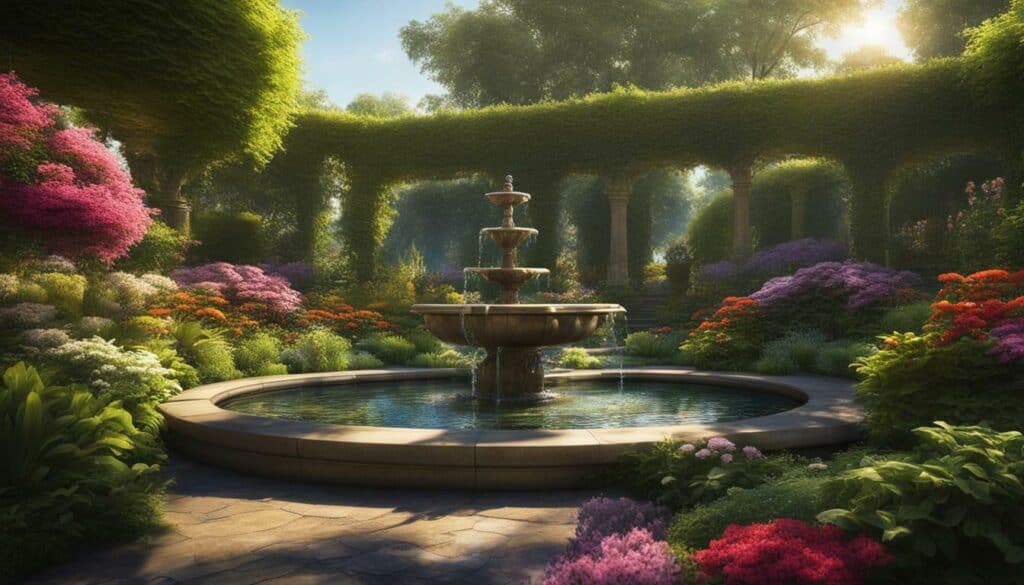
“Maximize the use of your small garden by partitioning it into functional zones, creating separate areas for lounging, dining, and gardening.”
Using Walls and Fences for Climbing Plants
Take advantage of walls and fences in your small garden by using climbing plants to create shade, enclosure, and natural barriers. Climbing plants not only add visual interest and beauty to your garden but also make efficient use of vertical space, allowing you to maximize your small garden area.
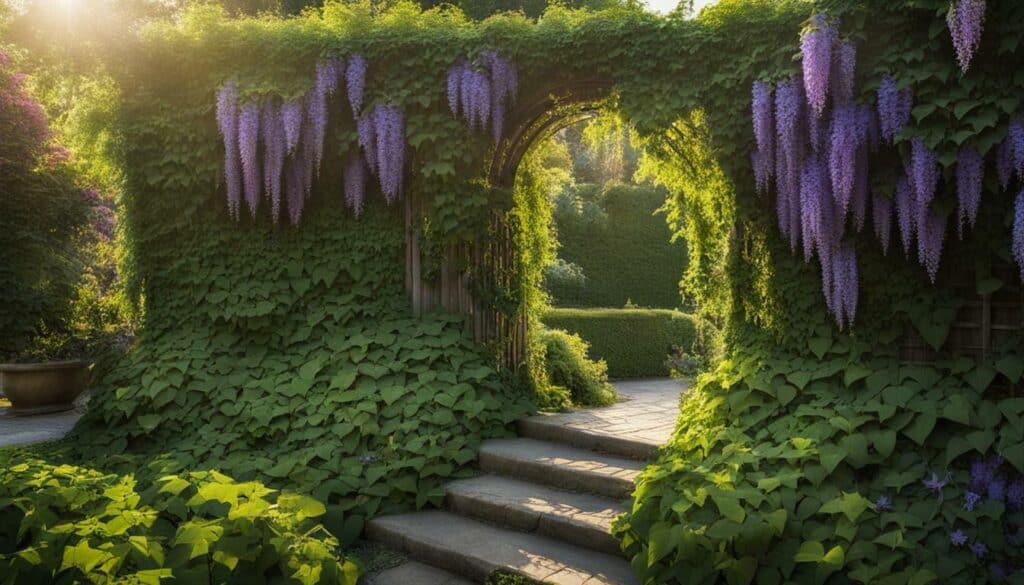
When selecting climbing plants for walls and fences, consider their growth habits, sunlight requirements, and the available space you have. Here are some popular climbing plants that can thrive in small gardens:
| Plant Name | Characteristics |
|---|---|
| Clematis | Beautiful flowers in a variety of colors, requires support |
| Honeysuckle | Fragrant flowers, attracts pollinators, fast-growing |
| Jasmine | Delicate flowers with a sweet fragrance, prefers sunny locations |
| Passionflower | Exotic-looking flowers, attracts butterflies, thrives in full sun |
When planting climbing plants, provide a sturdy trellis, arbor, or other support structure for them to climb on. This will help them grow in a controlled manner and prevent damage to your walls or fences. Consider the growth potential of each plant and ensure that it has enough space to spread out and flourish.
Remember to regularly maintain your climbing plants by pruning them to control their growth and remove any dead or damaged parts. Pruning will also help promote healthy growth and prevent your plants from becoming tangled or overgrown.
In addition to creating shade and enclosure, climbing plants can also serve as natural barriers, providing privacy and screening undesirable views. Consider carefully placing your climbing plants to create a sense of seclusion in your small garden.
Vertical Gardening Ideas:
- Train climbing roses along a fence to create a stunning display of blooms
- Grow ivy on a trellis to add lush greenery and texture to your garden
- Plant climbing hydrangeas near a wall to create a cascading effect of beautiful flowers
By utilizing walls and fences in your small garden and incorporating climbing plants, you can transform your space into a lush and visually appealing green paradise. Whether you choose fragrant flowers, vibrant blooms, or foliage-rich plants, the vertical elements in your garden will add depth, beauty, and functionality to your outdoor space.
Conclusion
Creating a green paradise in your garden is a rewarding journey that begins with careful planning and continues with ongoing care and attention. By following these gardening tips, you can transform your small garden into a vibrant and flourishing space. Start by designing your small garden with space-saving techniques and selecting the right plants for your compact area. Consider adding vertical elements and distributing the garden space into functional zones. Utilize walls and fences for climbing plants and create a visually stunning green space. Remember to establish goals, choose the right plants, and add depth to the garden visual using colors and textures. Embrace small-space gardening ideas, focus on foliage, and incorporate edible plants and hardscape accents. Nurture your garden with proper maintenance and utilize natural pest control methods. And most importantly, enjoy the journey and embrace the beauty of nature as you create your own green oasis.
FAQ
Q: How often should I water my garden?
A: The watering frequency depends on various factors, such as the plant’s water needs, soil type, and weather conditions. Generally, it’s best to water deeply but less frequently to encourage strong root growth.
Q: Can I use kitchen scraps for composting?
A: Yes, kitchen scraps like fruit peels, vegetable trimmings, and coffee grounds are excellent additions to your compost pile. Avoid meat and dairy products, as they may attract pests.
Q: What are some low-maintenance plants for beginners?
A: If you’re new to gardening, consider starting with plants like succulents, marigolds, and zinnias, as they are relatively easy to care for.
Q: How do I attract butterflies to my garden?
A: Planting nectar-rich flowers like lavender, butterfly bush, and coneflowers will attract butterflies to your garden. Providing a shallow water source also helps.
Q: Can I grow vegetables in a small garden?
A: Absolutely! Many vegetables can be grown in containers or raised beds, making them suitable for small gardens or even balconies.
What Are Some Essential Tips for Urban Gardening Success?
Mastering urban gardening requires careful planning and attention to detail. Start by choosing appropriate containers or utilizing vertical spaces. Opt for low-maintenance plants that thrive in limited sunlight. Regularly monitor moisture levels and provide adequate drainage. Implement companion planting to maximize yield and deter pests. Lastly, research and apply organic fertilizers and pest control methods to ensure a flourishing urban garden.





Leave a Reply